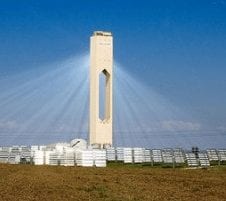It is ironic that in the same week that the ambitious $1.2 billion Solar Dawn solar thermal project in south-west Queensland should finally be put to rest, construction of two solar thermal projects – with storage – should begin in South Africa.
The last chance for the Solar Dawn consortium led by French nuclear giant Areva for the construction of a 250MW solar thermal plant in Queensland, or even a scaled down version of it, was removed when the Australian Renewable Energy Agency rejected its funding proposal – after the federal government had done so under the previous Solar Flagships program.
Meanwhile, in South Africa, the Spanish group Abengoa last week began construction of two solar thermal projects boasting a mixture of solar tower and parabolic trough technologies. The 50MW Khi Solar One and 100MW KaXu Solar One CSP (concentrating solar power, another name for solar thermal) projects will feature storage and dry cooling technologies, to reduce water demands.
These are the sort of projects that should be pioneered and deployed in Australia. Instead, Australia’s obsession with grandiose schemes, its inflexible funding arrangements, and the lack of true support from state governments and major utilities, mean South Africa will lead and Australia will follow.
The failure of the Solar Flagships program, or the inability of various projects to lock in power price arrangements is not a failure of technology, as many would like to portray it, but a failure of policy – where the hubris of government overwhelms sound technical advice from the industry. It was an idea dreamed up by the egos in the office of Prime Minister Kevin Rudd, and the bureaucrats were never able to meet the impossible task of matching such grandiose dreams – of having the biggest, but not necessarily the best – with sound policies. The coup-de-grace was delivered by Queensland Premier Campbell Newman in a similarly grand-standing gesture.
Greg Bourne, the chairman of the Australian Renewable Energy Agency, is now tasked with addressing that policy shortfall, but at least he has more realistic goals. And certainly there is no room for sentiment. Effectively, the first act of Ivor Frischknecht, the CEO of ARENA, has been to reject a project featuring the technology in which he was once an investor, in his role at Starfish Ventures, which was an investor in Ausra, which developed the compact linear reflector technology that Solar Dawn was proposing to use.
Given the funds at his disposal, and his timeframe, Bourne and Frischknecht have indicated that he will be focusing on regional and remote regions, and looking at hybrid solutions in areas where fossil fuel is already expensive.
The one opportunity that Australia now has for a solar thermal project in the short term may well be in Port August, where Alinta has held some discussions with ARENA, for a possible replacement of its coal-fired power stations there. What they may propose, however, is a hybrid systems no dissimilar to the solar booster that is currently being built in Queensland by Areva.
But the importance of solar thermal should not be underestimated. Even the Energy White Paper, a conservative document prepared by the Federal Energy ministry and released last week, said 16 per cent of Australia’s electricity demand could be sourced from solar thermal by 2050. That could make Australia a leader in solar thermal, but for the moment it trails.
That, however, was built around a rather conservative estimate of CSP costs. The Energy White Paper estimates CSP estimates costs of $322-$399/MWh. This compares to $280/MWh in the South African case, and estimates of around $250/MWh by Australia’s solar industry.
South Africa is succeeding with stand alone systems because it has introduced a market-focused system that has successfully attracted many of the world’s largest solar and other alternative energy developers, through an auction-based system that has attracted more than $5 billion of projects in its first two auctions.
The ACT is the only state or territory government that has pursued a similar strategy, albeit at a much smaller scale. It has so far had one round of bidding that should see a 20MW solar PV project being built near Canberra by the end of 2013.
In South Africa, the Khi Solar One and KaXu Solar One projects both have power purchase agreements with the state-owned power utility Eskom in place, and financing with a range of South African and international financial institutions.
Abengoa says the dry cooling technologies will reduce water consumption by around two thirds compared to other CSP plants, while Khi Solar One will have two hours storage, and Kaxu will have three hours storage to provide greater flexibility and the ability to dispatch power to meet demand after sunset.
The tragedy is that those projects could, and should, have been built first in Australia. But Australia was too obsessed with projects of a grandiose nature that it lost the opportunity.






